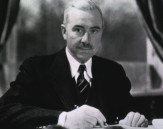by Joan Rachlin, JD, MPH, Executive Director
Last week, Lawrence Altman, MD, The New York Times’ senior statesman of science writing, published a piece titled “Of Medical Giants, Accolades and Feet of Clay.” The article focused on the life and work of Dr. Thomas Parran, Jr., the sixth surgeon general of the United States (from 1936 to 1948). Dr. Parran was, by most accounts, a committed, proactive, and effective “giant of medicine.”
But it was under his watch that two of the most egregious violations of research ethics in this country occurred, and, as a result, the American Sexually Transmitted Disease Association (ASTDA) is now debating whether or not to remove Dr. Parran’s name from the eponymous award that is conferred annually for “lifetime achievement in preventing and controlling sexual infections.” These two studies were funded and conducted under the aegis of the United States Public Health Service during his tenure, and both are well known to those in the PRIM&R community. Despite that, I’d like to provide a brief recap of each study and then ask whether you think Dr. Parran’s name should be stripped from the ASTDA award.
The “Tuskegee Study of Untreated Syphilis in the Negro Male,” which was carried out from 1932 to 1972, was designed to observe and record the natural course of syphilis in black men who were living and working as sharecroppers in Macon County, Alabama. Of the 600 subjects who were enrolled in the study, 399 in the experimental group had the disease and the rest were used as controls. At the outset of the study, there was no treatment for syphilis, but in 1947, penicillin became standard therapy for the disease. Despite its availability and efficacy, though, the drug was not given to either the infected men or those being used as controls. A number of the subjects died during the course of the study, and many of their wives, children, and sexual partners were infected.
There was no informed consent, and the men were never told the truth about the study; instead, they were told that they were being treated for “bad blood,” which was an umbrella term used at that time for sexually transmitted diseases, anemia, and other blood disorders. The men were enticed into participating by the promise of medical care, free meals, rides to the clinic, and, perhaps most importantly for these impoverished individuals, burial insurance. It was only when Peter Buxtun, a courageous epidemiologist studying sexually transmitted diseases, leaked word of the study to reporter Jean Heller that the world learned of this volcanic violation of human rights, ethical principles, and medical precepts. Ms. Heller’s story appeared in the Washington Star on July 25, 1972, and was picked up by The New York Times the following day. A public outcry ensued, an advisory panel was convened, and the study was subsequently terminated. Years later, in 1997, a formal apology was issued to the survivors, their families, and to the families of the deceased men by President Bill Clinton.
The second study that occurred under Dr. Parran’s watch wasn’t exposed until October 2010, when Wellesley College professor and medical historian, Susan Reverby, reported in a journal article that physicians from the United States had deliberately infected Guatemalan prostitutes, prisoners, soldiers, and mental patients with syphilis, gonorrhea, and chancroid. The U.S. researchers enlisted Guatemalan health ministries and officials in this study, and before it ended, nearly 700 men and women had been exposed to these infections without their informed consent. Unlike the Tuskegee study, the subjects in Guatemala were given antibiotics, but the records don’t indicate whether or not they were successfully treated. Dr. John Charles Cutler, who worked on the Tuskegee research, was the principal investigator in the Guatemalan study. According to the article, Dr. Parran told a colleague at the time that “the Guatemalan experiments could not have been conducted in the United States.” In October 2010, both then Secretary of State Hillary Clinton and Department of Health and Human Services Secretary Kathleen Sebelius formally apologized to Guatemala for conducting these experiments.
Dr. Altman, in the best journalistic tradition, reports “just the facts, ma’am,” and leaves the conclusion-drawing task to the readers. If you were on the ASTDA committee being asked to decide the future of the Parran Award, what would you recommend? Would, as the article suggests, retaining his name and including the full story of his involvement in these amoral studies be a useful consciousness raising reminder? Or, does the ignominy of his involvement trump the many productive things he did in the course of his career and tarnish the meaning of the award? In any case, the New York Times article reminds us that tending the research ethics flame requires courage, commitment, consistency, and constancy, and I thank you for your vital and essential work as flame tenders.




No comments! Be the first commenter?